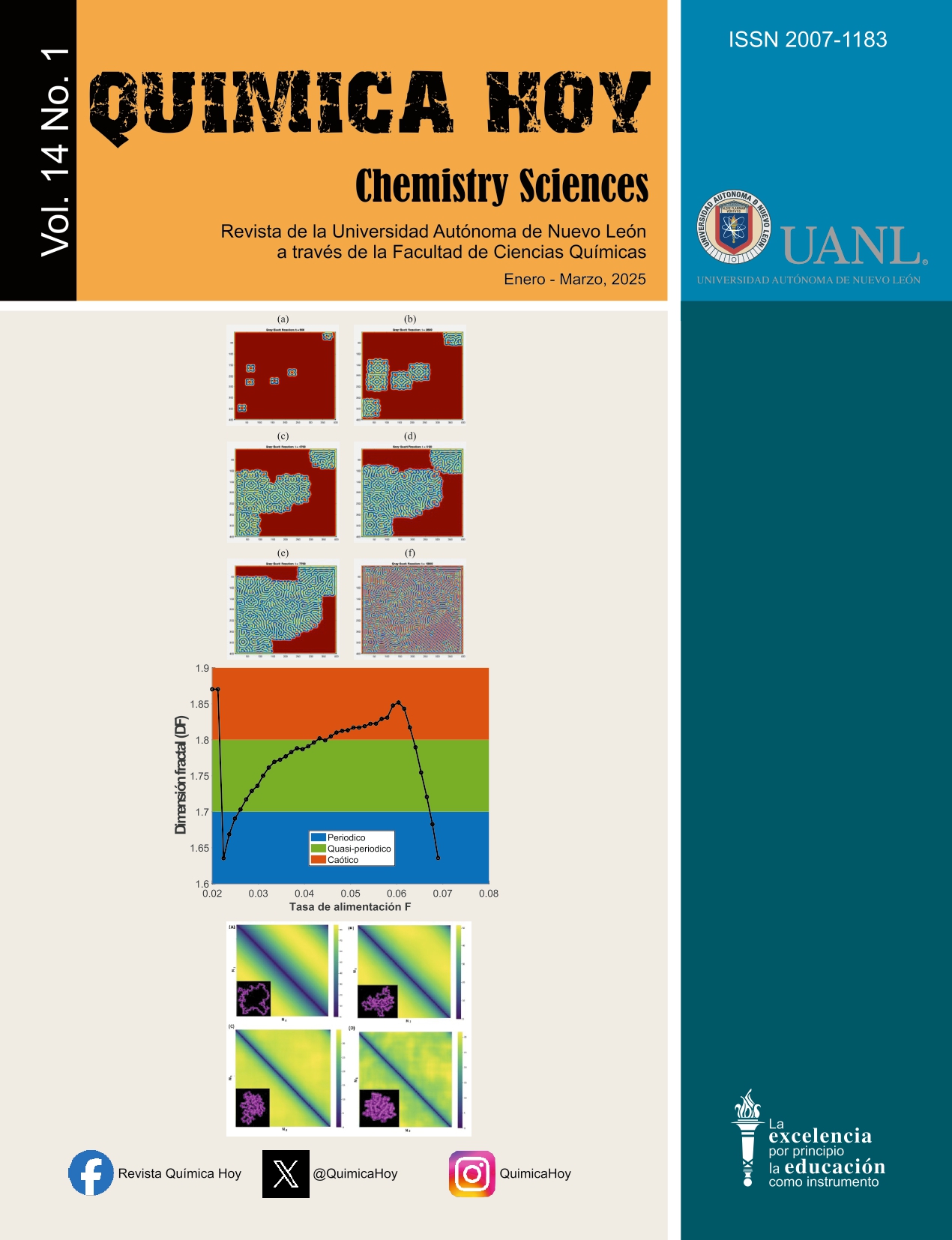Estados de equilibrio de un polímero anillo por medio del tensor de radio de giro
DOI:
https://doi.org/10.29105/qh14.01-465Keywords:
Estados equilibrio, Radio de giro, Simulación, Polímero anilloAbstract
En este trabajo, utilizando la técnica de simulación por dinámica molecular en un ensamble canónico, se muestra como la matriz de radio de giro Rg de un polímero anillo nos permite caracterizar las diversas configuraciones de equilibrio que adquiere el sistema, en función de las interacciones que tiene con una superficie atractiva y el tipo de solvente. Los resultados muestran el cambio sistemático que sufre la matriz de radio de giro Rg en función de los valores de interacción con la superficie y el solvente, permitiendo con ello generar la caracterización de las posibles configuraciones del polímero anillo.
Downloads
References
- [1]. Szleifer, I. (1997). Protein adsorption on surfaces with grafted polymers: A theoretical approach. Biophys. J., 72(2, Part 1), 595–612. DOI: https://doi.org/10.1016/S0006-3495(97)78698-3
- [2]. Rabe, M., Verdes, D., and Seeger, S. (2011). Understanding protein adsorption phenomena at solid surfaces. Adv. Colloid Interface Sci., 162(1), 87–106. DOI: https://doi.org/10.1016/j.cis.2010.12.007
- [3]. Besteman, K., Lee, J.-O., Wiertz, F. G. M., Heering, H. A., and Dekker, C. (2003). Enzyme-coated carbon nanotubes as single-molecule biosensors. Nano Lett., 3(6):727– 730. DOI: https://doi.org/10.1021/nl034139u
- [4]. Egorov, S. A., Milchev, A., Virnau, P., and Binder, K. (2016). Semiflexible polymers under good solvent conditions interacting with repulsive walls. J. Chem. Phys., 144(17), 174902-174103. DOI: https://doi.org/10.1063/1.4947254
- [5]. Milchev, A. and Binder, K. (2019). Linear dimensions of adsorbed semiflexible polymers: What can be learned about their persistence length? Phys. Rev. Lett., 123, 128003. DOI: https://doi.org/10.1103/PhysRevLett.123.128003
- [6]. Milchev, A., Egorov, S., Nikoubashman, A., and Binder, K. (2017). Conformations and orientational ordering of semiflexible polymers in spherical confinement. J. Chem. Phys., 146, 194907. DOI: https://doi.org/10.1063/1.4983131
- [7]. Gomez, D. y Gonzalez-Amezcua, O. (2023). Evolution of phase diagrams of polymer adsorption over attractive surfaces as a function of flexibility and solvent quality. Molecular Simulation, 49, (13), 1350-1364. DOI: https://doi.org/10.1080/08927022.2023.2229455
- [8]. Hoover, W. G. (1985). Canonical dynamics: Equilibrium phase-space distributions. Phys. Rev. A, 31, 1695–1697. DOI: https://doi.org/10.1103/PhysRevA.31.1695
- [9]. M. Moddel, Bachmann, M., and W. Janke. (2009) Conformational Mechanics of polymer adsorption transitions at attractive substrates. J. Phys. Chem. B. Vol. 113(11), 3314–3323. DOI: https://doi.org/10.1021/jp808124v
- [10]. Bird, R. B., Armstrong, R. C., and Hassager, O. (1987). Dynamics of polymeric liquids. Volume 1: fluid mechanics. A Wiley-Interscience Publication, John Wiley & Sons, New York, 2 edition
- [11]. Moddel, M., Janke, W., and Bachmann, M. (2011). Comparison of the adsorption transition for grafted and nongrafted polymers. Macromolecules, 44(22), 9013–9019. DOI: https://doi.org/10.1021/ma201307c
- [12]. Daan Frenkel, B. S. (2001). Understanding Molecular Simulation. Academic Press, San Diego, 2 edition.
- [13]. Reddy, G. and Yethiraj, A. (2006). Implicit and explicit solvent models for the simulation of dilute polymer solutions. Macromolecules, 39(24), 8536–8542. DOI: https://doi.org/10.1021/ma061176+
Downloads
Published
How to Cite
Issue
Section
License
Copyright (c) 2025 Brandon Geovany Calamaco Alanis, Jessica Judit Perez Torres, Omar Gonzalez Amezcua

This work is licensed under a Creative Commons Attribution 4.0 International License.





